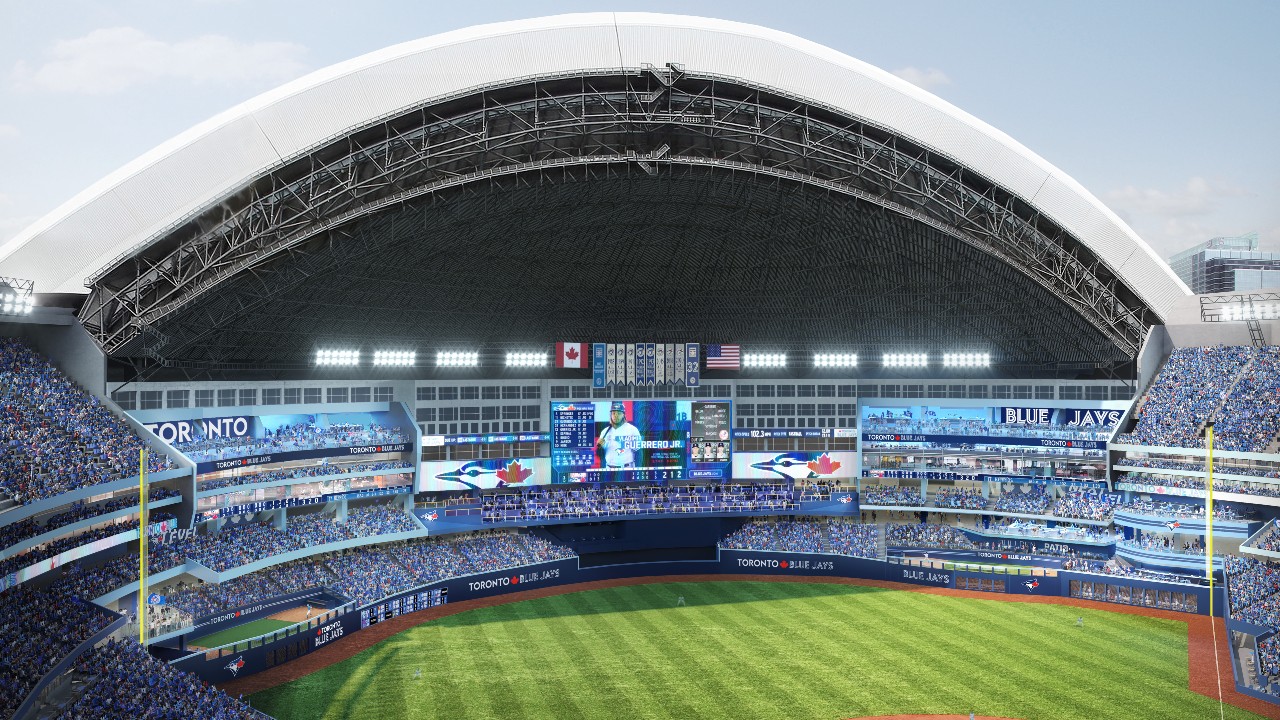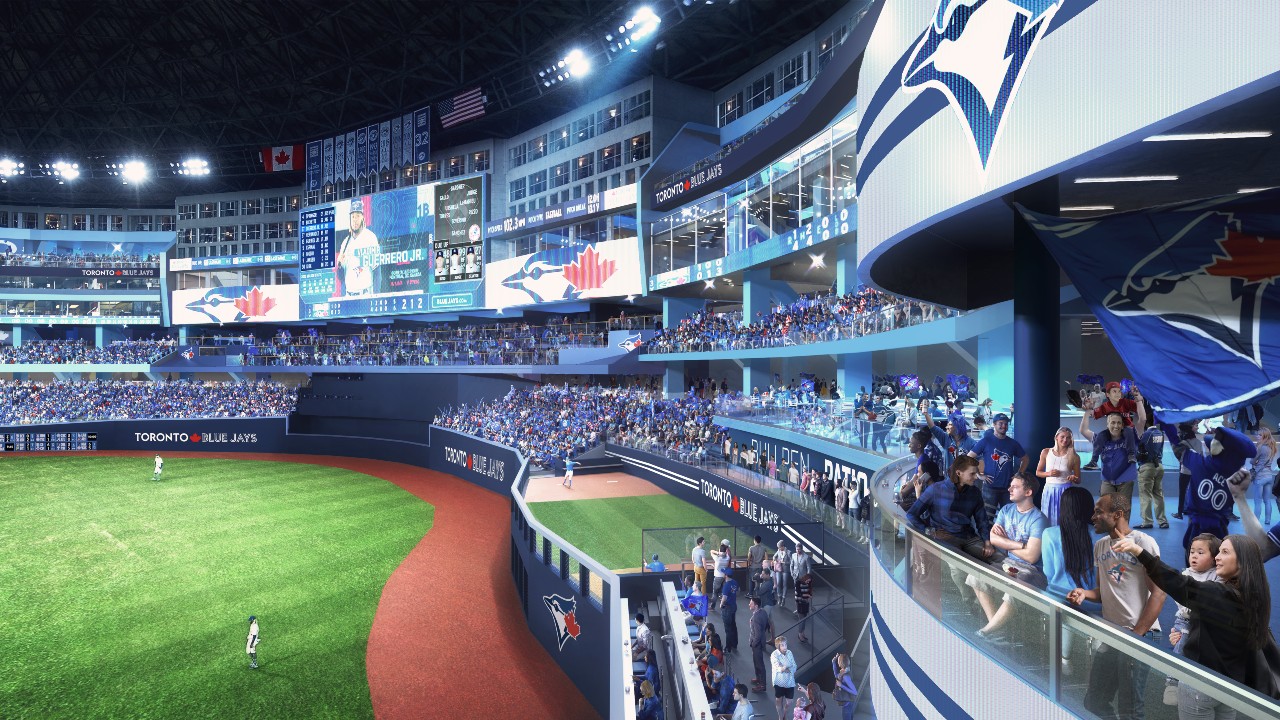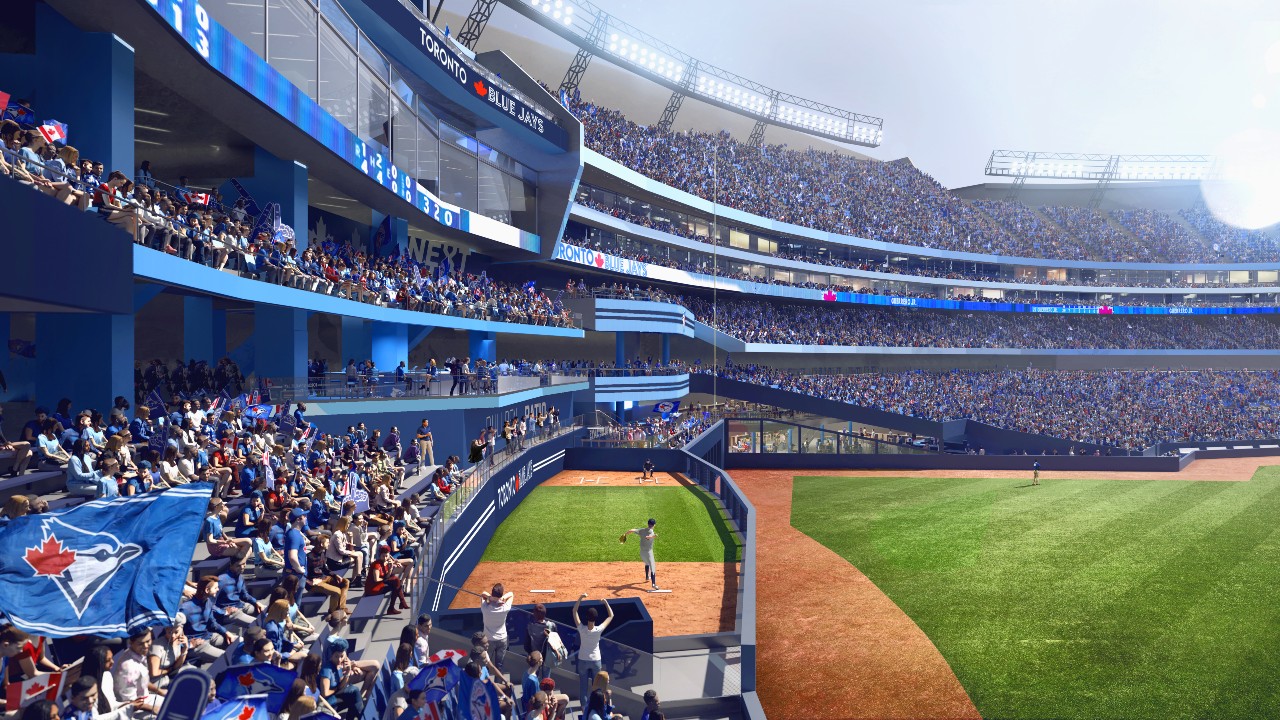TORONTO — During the sixth inning Tuesday night, George Springer lined a grand slam 413-feet to left-centre, busting open a tied ballgame as nearly 40,000 fans around him broke into bedlam. At most ballparks, that electric moment would have produced a souvenir for one lucky spectator somewhere beyond the outfield wall. But not at Rogers Centre. Not in Toronto, where, as he rounded the bases with his right arm in the sky, Springer watched his ball disappear into “the abyss.”
At least that’s what Toronto Blue Jays president and CEO Mark Shapiro calls it. It’s the gap between the outfield wall and the first row of seats, which gives way to a service level ringing around a stadium first built over three decades ago as a multi-purpose facility — not a ballpark. An arena that could be converted from a baseball configuration to a football one and back. A place that could hold concerts and ice dancing and monster truck rallies. An engineering marvel that fit its era and has since grown miserably outdated.
It's a sight Shapiro hopes never to see again starting in the 2023 regular season, when the Blue Jays plan to have completed the first phase of a $300-million, privately-funded, multi-year Rogers Centre renovation project that will break ground as soon as his team’s current season concludes.
“It’s been a long time coming,” Shapiro said. “When fans come into the building next year, sit in [200-level] seats and the seats below, with the Canadian flag unfurled in the field, it will be a dramatically different vision. A dramatically different vista. And a different ballpark. But that will just be the start. It'll be the season or two to follow that re-envision the entire lower bowl and really turn this stadium into a ballpark.”
While the full renovation will impact nearly every part of the stadium’s interior, including a full overhaul of the 33-year-old building’s lower bowl, this winter’s work will focus primarily on Rogers Centre’s outfield.
The ballpark’s bullpens will be raised from the field of play and surrounded by both traditional and bleacher seating, as well as viewing platforms that will allow fans to watch relievers warming up to enter games. Several new fan congregation areas will be added around the 100- and 200-level, while outfield seating closest to the field will extend forward to the ballpark’s realigned walls.
“It's going to create a really unique opportunity for our fans to encourage our relievers and potentially discourage — that's the kindest word I could possibly use — our opposing relief pitchers,” Shapiro said. “I think they'll enjoy some of the hometown flavor as our fans will be right on top of the visiting bullpen.”
In the right-field corner, where many of Rogers Centre’s current seats don’t point towards the pitcher’s mound, the club plans to rip out rows of seats and create a series of decks around the foul pole that will accommodate future fan congregation areas. The club’s renderings depict a bar in the right-field corner and seating within the outfield walls.
Outfield seats in the 500 level will be removed, as well, making way for a pair of new non-ticketed areas overlooking left and right field where fans can gather and watch games. One of the areas will be family-focused while the other will house a bar.
Changes to the 500 level won’t be limited to the outfield, however, as every seat around the upper bowl — currently the same ones installed when the building opened in 1989 — will be removed and replaced.
Beneath the surface, the club will build a new family area and 5,000-sq. ft. weight room for its players, as well as staff locker rooms. The ultimate goal is to recreate the environment and facilities Blue Jays players and staff have access to in Dunedin, Fla., where the club recently opened a state-of-the-art player development complex.
"When we're thinking about player facilities, we're thinking about, 'How do we provide our players with resources, tools, technology, spaces, and, really, design that fosters championship culture and expectations?'" Shapiro said. “We want — as the players get out in the fraternity of Major League Baseball players — it to be clear that this is the best place to play. It's clear that we do care about them. That is a recruiting tool for us and a tool for us in retaining our players."
Eventually, those player facilities will include a redesigned clubhouse, sleep and yoga rooms, hydrotherapy areas, and more. But many of those upgrades will wait until the next phase of the renovation in the 2023-24 off-season, when the club plans to demolish and replace Rogers Centre’s entire 100-level infield bowl.
That will remove much of what’s contained within the abyss where Springer’s grand slam fell — a labyrinth of concrete and steel structures that run around the stadium and facilitated the rotating of Rogers Centre’s lower bowl when it was still hosting football games. All that infrastructure has sat idle since the CFL’s Toronto Argonauts left Rogers Centre for BMO Field in 2016. And it’s currently the largest impediment to the Blue Jays building out new fan areas and player facilities within the 100 level.
“It’s hard to even imagine,” Shapiro said. “We’ll be taking out all of that steel, all of that concrete, and creating an entirely new 100 level that’s got premium spaces and clubs, that's got much better vantage points for the field of play. It’ll be closer to the field of play and create more interaction with our fans. And then it’ll bring the opportunity to finish off and completely re-envision the player experience down there.”
The Rogers Centre renovation is being piloted by Populous, the same architectural firm that designed the club’s new Dunedin facility. The project is intended to buy the Blue Jays 10-15 years to envision a longer-term solution for its outdated stadium, MLB’s seventh oldest. Work will be conducted in phases over future winters, pausing during the regular season so the Blue Jays can play their home schedule uninterrupted.
Originally, the Blue Jays envisioned splitting the renovation over two off-seasons, completing around 30 per cent of the work this winter and the final 70 per cent in the winter of 2023-24. But the club is now framing the project as one that will be “phased over the coming two to three off-seasons,” suggesting some work could spill over to the winter of 2024-25 if construction is delayed or contractors run into supply chain issues.
In recent years, the club has made several smaller-scale upgrades throughout the building, including replacing the playing surface in 2021, and installing a new, 8,000-sq. ft. videoboard prior to the 2022 season. But this will be Rogers Centre’s first major renovation since the stadium opened.
And it won’t be its last. As soon as work in completed ahead of either the 2024 or 2025 regular season, Shapiro says the club will begin the planning process for a new, long-term facility — either within Rogers Centre’s current footprint or elsewhere in the city.
“This is a medium-term solution,” Shapiro said. “We still need to have a long-term solution at some point.”

Throughout the current renovation process, the building’s capacity will reduce as current seats are converted to fan congregation spaces. The club is still working through what the final number will be at the conclusion of the project, but it’s expected to land somewhere between 40,000 and the stadium’s current capacity of over 49,000.
The renovations will also likely impact Rogers Centre as an offensive environment. The Blue Jays aren’t yet revealing the specifics of the stadium’s new outfield dimensions, but we do know it will be an asymmetrical boundary and that the fences will jut in slightly to accommodate the elevated bullpens.
The club’s analytics department has spent time modelling how the changes could impact the results of balls in play, searching for an alignment that will not dramatically alter Rogers Centre’s competitive nature. But it is expected that the unique angling and heights of the new outfield fences could lead to some tricky bounces for outfielders to assess.
An interesting wrinkle is that Rogers Centre’s foul territory — currently the second-largest in MLB — will be decreased to bring fans closer to gameplay during subsequent phases of the renovation. That won’t only have a positive impact on fan experience — it will likely have a positive impact on runs scored. Fewer foul balls will result in outs, extending plate appearances and giving hitters extra chances to put pitches in play.
But more important for fans in Rogers Centre’s outfield seats are the balls that don’t land in play. The balls like Springer’s that fall into the abyss. Starting next season, those balls will find a pair of hands.
"That will no longer be an issue. Every home run hit in the outfield will be into our group of fans that will be hovering on the outfield fence,” Shapiro said. “It’s going to be a dramatically different look on opening day 2023.”
Editor's Note: One of the 30 MLB teams, the Toronto Blue Jays, is owned by Rogers Communications Inc., which also owns Sportsnet.







